Contract Law Analysis: Elements, Terms, and Liability in a Scenario
VerifiedAdded on 2019/12/03
|13
|4664
|301
Report
AI Summary
This report provides a comprehensive analysis of contract law, beginning with an introduction to the essential elements required for a valid contract, including offer, acceptance, consideration, capacity, and intention to create legal relations. It then explores different types of contracts, such as written, oral, distance, face-to-face, bilateral, and unilateral contracts. The report also delves into various forms of contractual terms, including exclusion clauses, express terms (conditions, warranties, and in-nominate terms), and implied terms. The core of the report applies these legal concepts to a scenario, evaluating the essential elements of a contract, analyzing the terms, and assessing the remedies available. Furthermore, it contrasts liability in tort with contractual liability, explaining the nature of liability in negligence and the concept of vicarious liability, using examples to illustrate these principles. Finally, the report applies the elements of the tort of negligence and the law on vicarious liability to the given scenario, providing a complete legal analysis.

ACNB
1
1
Paraphrase This Document
Need a fresh take? Get an instant paraphrase of this document with our AI Paraphraser
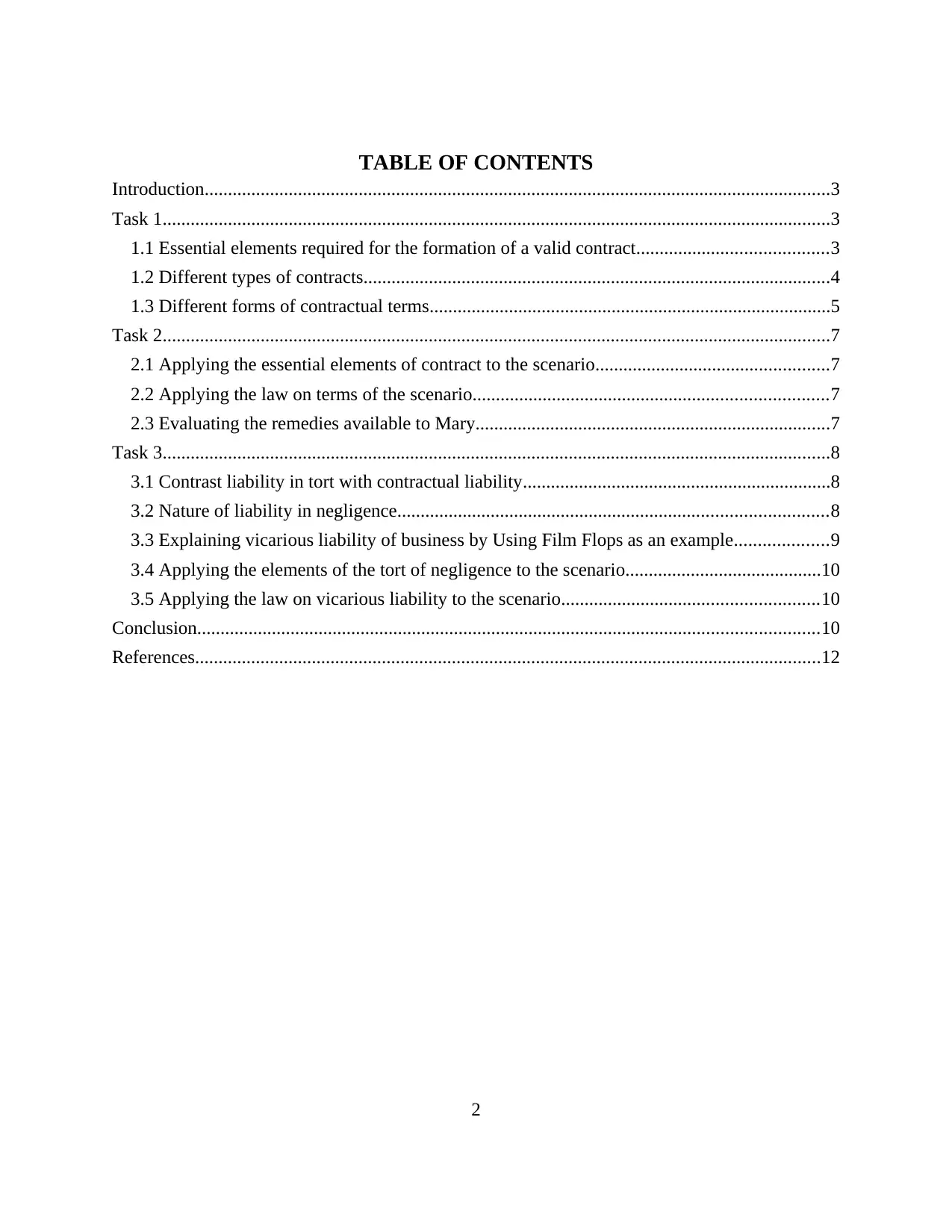
TABLE OF CONTENTS
Introduction......................................................................................................................................3
Task 1...............................................................................................................................................3
1.1 Essential elements required for the formation of a valid contract.........................................3
1.2 Different types of contracts....................................................................................................4
1.3 Different forms of contractual terms......................................................................................5
Task 2...............................................................................................................................................7
2.1 Applying the essential elements of contract to the scenario..................................................7
2.2 Applying the law on terms of the scenario............................................................................7
2.3 Evaluating the remedies available to Mary............................................................................7
Task 3...............................................................................................................................................8
3.1 Contrast liability in tort with contractual liability..................................................................8
3.2 Nature of liability in negligence............................................................................................8
3.3 Explaining vicarious liability of business by Using Film Flops as an example....................9
3.4 Applying the elements of the tort of negligence to the scenario..........................................10
3.5 Applying the law on vicarious liability to the scenario.......................................................10
Conclusion.....................................................................................................................................10
References......................................................................................................................................12
2
Introduction......................................................................................................................................3
Task 1...............................................................................................................................................3
1.1 Essential elements required for the formation of a valid contract.........................................3
1.2 Different types of contracts....................................................................................................4
1.3 Different forms of contractual terms......................................................................................5
Task 2...............................................................................................................................................7
2.1 Applying the essential elements of contract to the scenario..................................................7
2.2 Applying the law on terms of the scenario............................................................................7
2.3 Evaluating the remedies available to Mary............................................................................7
Task 3...............................................................................................................................................8
3.1 Contrast liability in tort with contractual liability..................................................................8
3.2 Nature of liability in negligence............................................................................................8
3.3 Explaining vicarious liability of business by Using Film Flops as an example....................9
3.4 Applying the elements of the tort of negligence to the scenario..........................................10
3.5 Applying the law on vicarious liability to the scenario.......................................................10
Conclusion.....................................................................................................................................10
References......................................................................................................................................12
2
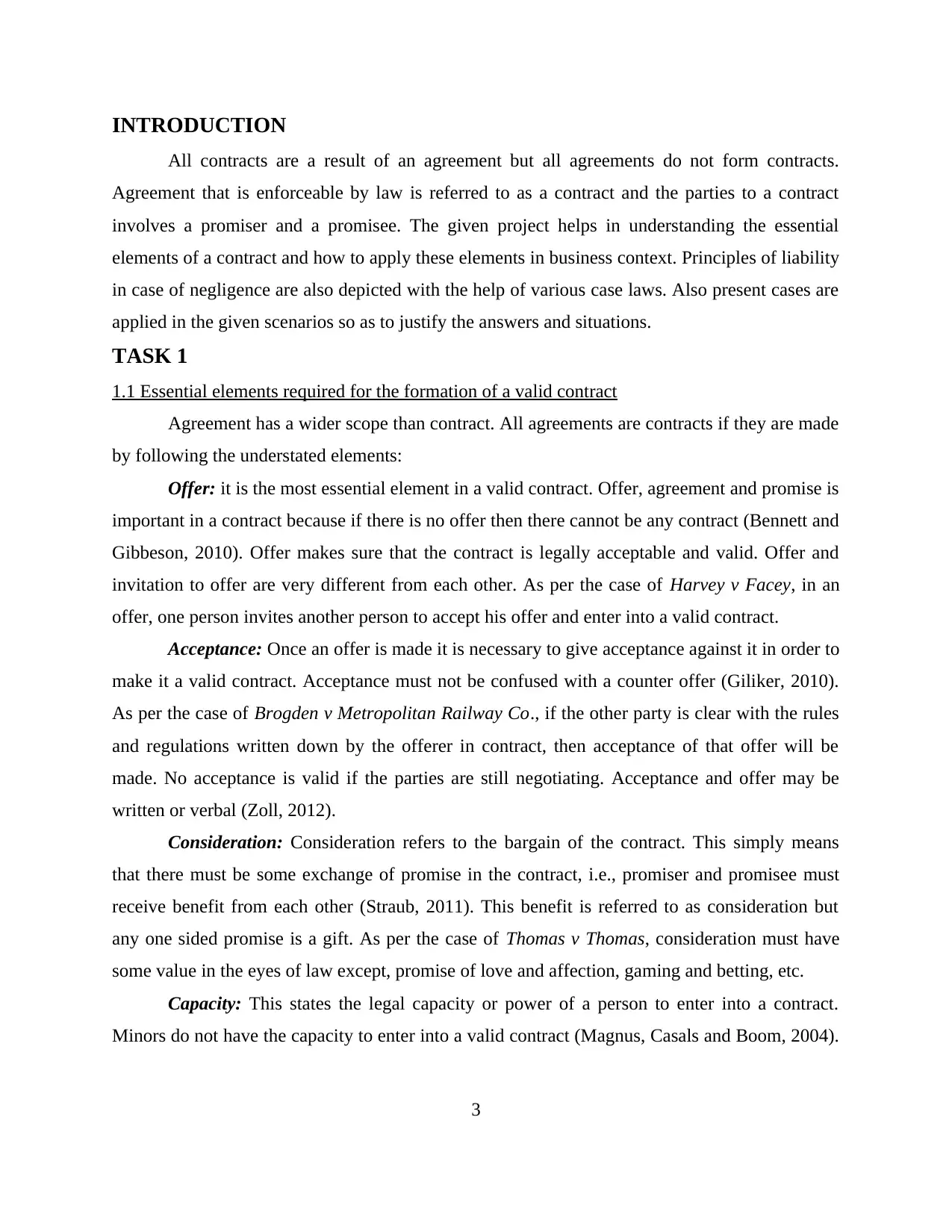
INTRODUCTION
All contracts are a result of an agreement but all agreements do not form contracts.
Agreement that is enforceable by law is referred to as a contract and the parties to a contract
involves a promiser and a promisee. The given project helps in understanding the essential
elements of a contract and how to apply these elements in business context. Principles of liability
in case of negligence are also depicted with the help of various case laws. Also present cases are
applied in the given scenarios so as to justify the answers and situations.
TASK 1
1.1 Essential elements required for the formation of a valid contract
Agreement has a wider scope than contract. All agreements are contracts if they are made
by following the understated elements:
Offer: it is the most essential element in a valid contract. Offer, agreement and promise is
important in a contract because if there is no offer then there cannot be any contract (Bennett and
Gibbeson, 2010). Offer makes sure that the contract is legally acceptable and valid. Offer and
invitation to offer are very different from each other. As per the case of Harvey v Facey, in an
offer, one person invites another person to accept his offer and enter into a valid contract.
Acceptance: Once an offer is made it is necessary to give acceptance against it in order to
make it a valid contract. Acceptance must not be confused with a counter offer (Giliker, 2010).
As per the case of Brogden v Metropolitan Railway Co., if the other party is clear with the rules
and regulations written down by the offerer in contract, then acceptance of that offer will be
made. No acceptance is valid if the parties are still negotiating. Acceptance and offer may be
written or verbal (Zoll, 2012).
Consideration: Consideration refers to the bargain of the contract. This simply means
that there must be some exchange of promise in the contract, i.e., promiser and promisee must
receive benefit from each other (Straub, 2011). This benefit is referred to as consideration but
any one sided promise is a gift. As per the case of Thomas v Thomas, consideration must have
some value in the eyes of law except, promise of love and affection, gaming and betting, etc.
Capacity: This states the legal capacity or power of a person to enter into a contract.
Minors do not have the capacity to enter into a valid contract (Magnus, Casals and Boom, 2004).
3
All contracts are a result of an agreement but all agreements do not form contracts.
Agreement that is enforceable by law is referred to as a contract and the parties to a contract
involves a promiser and a promisee. The given project helps in understanding the essential
elements of a contract and how to apply these elements in business context. Principles of liability
in case of negligence are also depicted with the help of various case laws. Also present cases are
applied in the given scenarios so as to justify the answers and situations.
TASK 1
1.1 Essential elements required for the formation of a valid contract
Agreement has a wider scope than contract. All agreements are contracts if they are made
by following the understated elements:
Offer: it is the most essential element in a valid contract. Offer, agreement and promise is
important in a contract because if there is no offer then there cannot be any contract (Bennett and
Gibbeson, 2010). Offer makes sure that the contract is legally acceptable and valid. Offer and
invitation to offer are very different from each other. As per the case of Harvey v Facey, in an
offer, one person invites another person to accept his offer and enter into a valid contract.
Acceptance: Once an offer is made it is necessary to give acceptance against it in order to
make it a valid contract. Acceptance must not be confused with a counter offer (Giliker, 2010).
As per the case of Brogden v Metropolitan Railway Co., if the other party is clear with the rules
and regulations written down by the offerer in contract, then acceptance of that offer will be
made. No acceptance is valid if the parties are still negotiating. Acceptance and offer may be
written or verbal (Zoll, 2012).
Consideration: Consideration refers to the bargain of the contract. This simply means
that there must be some exchange of promise in the contract, i.e., promiser and promisee must
receive benefit from each other (Straub, 2011). This benefit is referred to as consideration but
any one sided promise is a gift. As per the case of Thomas v Thomas, consideration must have
some value in the eyes of law except, promise of love and affection, gaming and betting, etc.
Capacity: This states the legal capacity or power of a person to enter into a contract.
Minors do not have the capacity to enter into a valid contract (Magnus, Casals and Boom, 2004).
3
⊘ This is a preview!⊘
Do you want full access?
Subscribe today to unlock all pages.

Trusted by 1+ million students worldwide
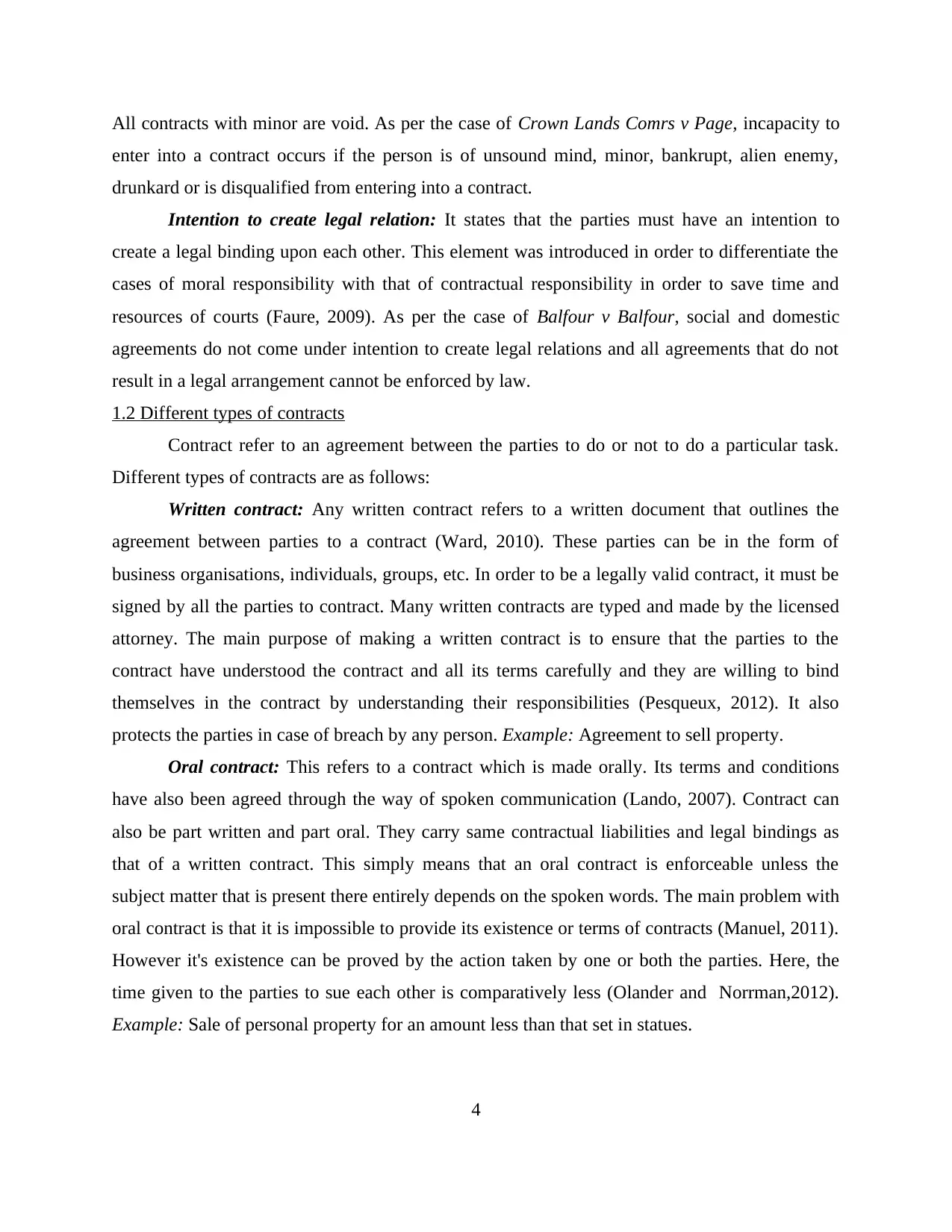
All contracts with minor are void. As per the case of Crown Lands Comrs v Page, incapacity to
enter into a contract occurs if the person is of unsound mind, minor, bankrupt, alien enemy,
drunkard or is disqualified from entering into a contract.
Intention to create legal relation: It states that the parties must have an intention to
create a legal binding upon each other. This element was introduced in order to differentiate the
cases of moral responsibility with that of contractual responsibility in order to save time and
resources of courts (Faure, 2009). As per the case of Balfour v Balfour, social and domestic
agreements do not come under intention to create legal relations and all agreements that do not
result in a legal arrangement cannot be enforced by law.
1.2 Different types of contracts
Contract refer to an agreement between the parties to do or not to do a particular task.
Different types of contracts are as follows:
Written contract: Any written contract refers to a written document that outlines the
agreement between parties to a contract (Ward, 2010). These parties can be in the form of
business organisations, individuals, groups, etc. In order to be a legally valid contract, it must be
signed by all the parties to contract. Many written contracts are typed and made by the licensed
attorney. The main purpose of making a written contract is to ensure that the parties to the
contract have understood the contract and all its terms carefully and they are willing to bind
themselves in the contract by understanding their responsibilities (Pesqueux, 2012). It also
protects the parties in case of breach by any person. Example: Agreement to sell property.
Oral contract: This refers to a contract which is made orally. Its terms and conditions
have also been agreed through the way of spoken communication (Lando, 2007). Contract can
also be part written and part oral. They carry same contractual liabilities and legal bindings as
that of a written contract. This simply means that an oral contract is enforceable unless the
subject matter that is present there entirely depends on the spoken words. The main problem with
oral contract is that it is impossible to provide its existence or terms of contracts (Manuel, 2011).
However it's existence can be proved by the action taken by one or both the parties. Here, the
time given to the parties to sue each other is comparatively less (Olander and Norrman,2012).
Example: Sale of personal property for an amount less than that set in statues.
4
enter into a contract occurs if the person is of unsound mind, minor, bankrupt, alien enemy,
drunkard or is disqualified from entering into a contract.
Intention to create legal relation: It states that the parties must have an intention to
create a legal binding upon each other. This element was introduced in order to differentiate the
cases of moral responsibility with that of contractual responsibility in order to save time and
resources of courts (Faure, 2009). As per the case of Balfour v Balfour, social and domestic
agreements do not come under intention to create legal relations and all agreements that do not
result in a legal arrangement cannot be enforced by law.
1.2 Different types of contracts
Contract refer to an agreement between the parties to do or not to do a particular task.
Different types of contracts are as follows:
Written contract: Any written contract refers to a written document that outlines the
agreement between parties to a contract (Ward, 2010). These parties can be in the form of
business organisations, individuals, groups, etc. In order to be a legally valid contract, it must be
signed by all the parties to contract. Many written contracts are typed and made by the licensed
attorney. The main purpose of making a written contract is to ensure that the parties to the
contract have understood the contract and all its terms carefully and they are willing to bind
themselves in the contract by understanding their responsibilities (Pesqueux, 2012). It also
protects the parties in case of breach by any person. Example: Agreement to sell property.
Oral contract: This refers to a contract which is made orally. Its terms and conditions
have also been agreed through the way of spoken communication (Lando, 2007). Contract can
also be part written and part oral. They carry same contractual liabilities and legal bindings as
that of a written contract. This simply means that an oral contract is enforceable unless the
subject matter that is present there entirely depends on the spoken words. The main problem with
oral contract is that it is impossible to provide its existence or terms of contracts (Manuel, 2011).
However it's existence can be proved by the action taken by one or both the parties. Here, the
time given to the parties to sue each other is comparatively less (Olander and Norrman,2012).
Example: Sale of personal property for an amount less than that set in statues.
4
Paraphrase This Document
Need a fresh take? Get an instant paraphrase of this document with our AI Paraphraser
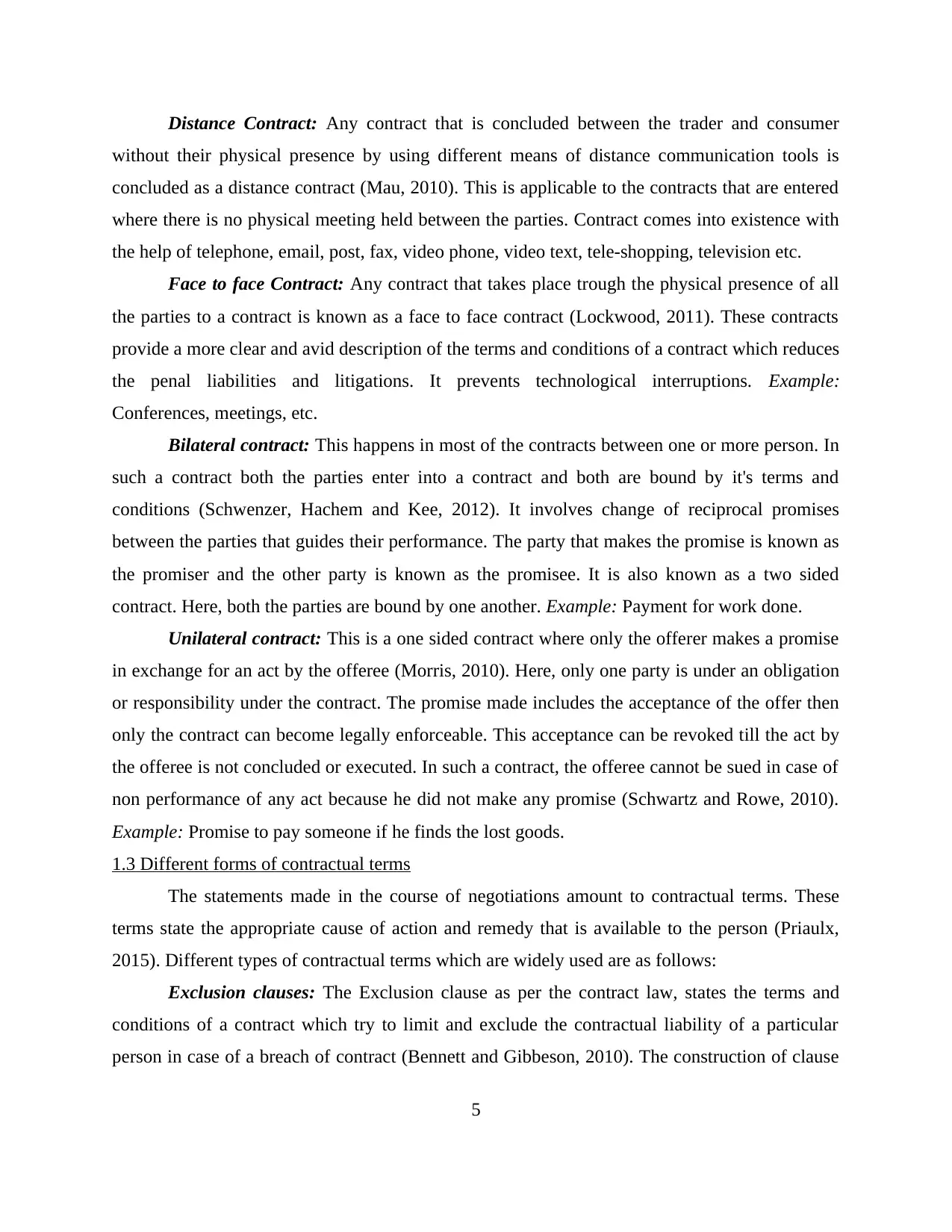
Distance Contract: Any contract that is concluded between the trader and consumer
without their physical presence by using different means of distance communication tools is
concluded as a distance contract (Mau, 2010). This is applicable to the contracts that are entered
where there is no physical meeting held between the parties. Contract comes into existence with
the help of telephone, email, post, fax, video phone, video text, tele-shopping, television etc.
Face to face Contract: Any contract that takes place trough the physical presence of all
the parties to a contract is known as a face to face contract (Lockwood, 2011). These contracts
provide a more clear and avid description of the terms and conditions of a contract which reduces
the penal liabilities and litigations. It prevents technological interruptions. Example:
Conferences, meetings, etc.
Bilateral contract: This happens in most of the contracts between one or more person. In
such a contract both the parties enter into a contract and both are bound by it's terms and
conditions (Schwenzer, Hachem and Kee, 2012). It involves change of reciprocal promises
between the parties that guides their performance. The party that makes the promise is known as
the promiser and the other party is known as the promisee. It is also known as a two sided
contract. Here, both the parties are bound by one another. Example: Payment for work done.
Unilateral contract: This is a one sided contract where only the offerer makes a promise
in exchange for an act by the offeree (Morris, 2010). Here, only one party is under an obligation
or responsibility under the contract. The promise made includes the acceptance of the offer then
only the contract can become legally enforceable. This acceptance can be revoked till the act by
the offeree is not concluded or executed. In such a contract, the offeree cannot be sued in case of
non performance of any act because he did not make any promise (Schwartz and Rowe, 2010).
Example: Promise to pay someone if he finds the lost goods.
1.3 Different forms of contractual terms
The statements made in the course of negotiations amount to contractual terms. These
terms state the appropriate cause of action and remedy that is available to the person (Priaulx,
2015). Different types of contractual terms which are widely used are as follows:
Exclusion clauses: The Exclusion clause as per the contract law, states the terms and
conditions of a contract which try to limit and exclude the contractual liability of a particular
person in case of a breach of contract (Bennett and Gibbeson, 2010). The construction of clause
5
without their physical presence by using different means of distance communication tools is
concluded as a distance contract (Mau, 2010). This is applicable to the contracts that are entered
where there is no physical meeting held between the parties. Contract comes into existence with
the help of telephone, email, post, fax, video phone, video text, tele-shopping, television etc.
Face to face Contract: Any contract that takes place trough the physical presence of all
the parties to a contract is known as a face to face contract (Lockwood, 2011). These contracts
provide a more clear and avid description of the terms and conditions of a contract which reduces
the penal liabilities and litigations. It prevents technological interruptions. Example:
Conferences, meetings, etc.
Bilateral contract: This happens in most of the contracts between one or more person. In
such a contract both the parties enter into a contract and both are bound by it's terms and
conditions (Schwenzer, Hachem and Kee, 2012). It involves change of reciprocal promises
between the parties that guides their performance. The party that makes the promise is known as
the promiser and the other party is known as the promisee. It is also known as a two sided
contract. Here, both the parties are bound by one another. Example: Payment for work done.
Unilateral contract: This is a one sided contract where only the offerer makes a promise
in exchange for an act by the offeree (Morris, 2010). Here, only one party is under an obligation
or responsibility under the contract. The promise made includes the acceptance of the offer then
only the contract can become legally enforceable. This acceptance can be revoked till the act by
the offeree is not concluded or executed. In such a contract, the offeree cannot be sued in case of
non performance of any act because he did not make any promise (Schwartz and Rowe, 2010).
Example: Promise to pay someone if he finds the lost goods.
1.3 Different forms of contractual terms
The statements made in the course of negotiations amount to contractual terms. These
terms state the appropriate cause of action and remedy that is available to the person (Priaulx,
2015). Different types of contractual terms which are widely used are as follows:
Exclusion clauses: The Exclusion clause as per the contract law, states the terms and
conditions of a contract which try to limit and exclude the contractual liability of a particular
person in case of a breach of contract (Bennett and Gibbeson, 2010). The construction of clause
5
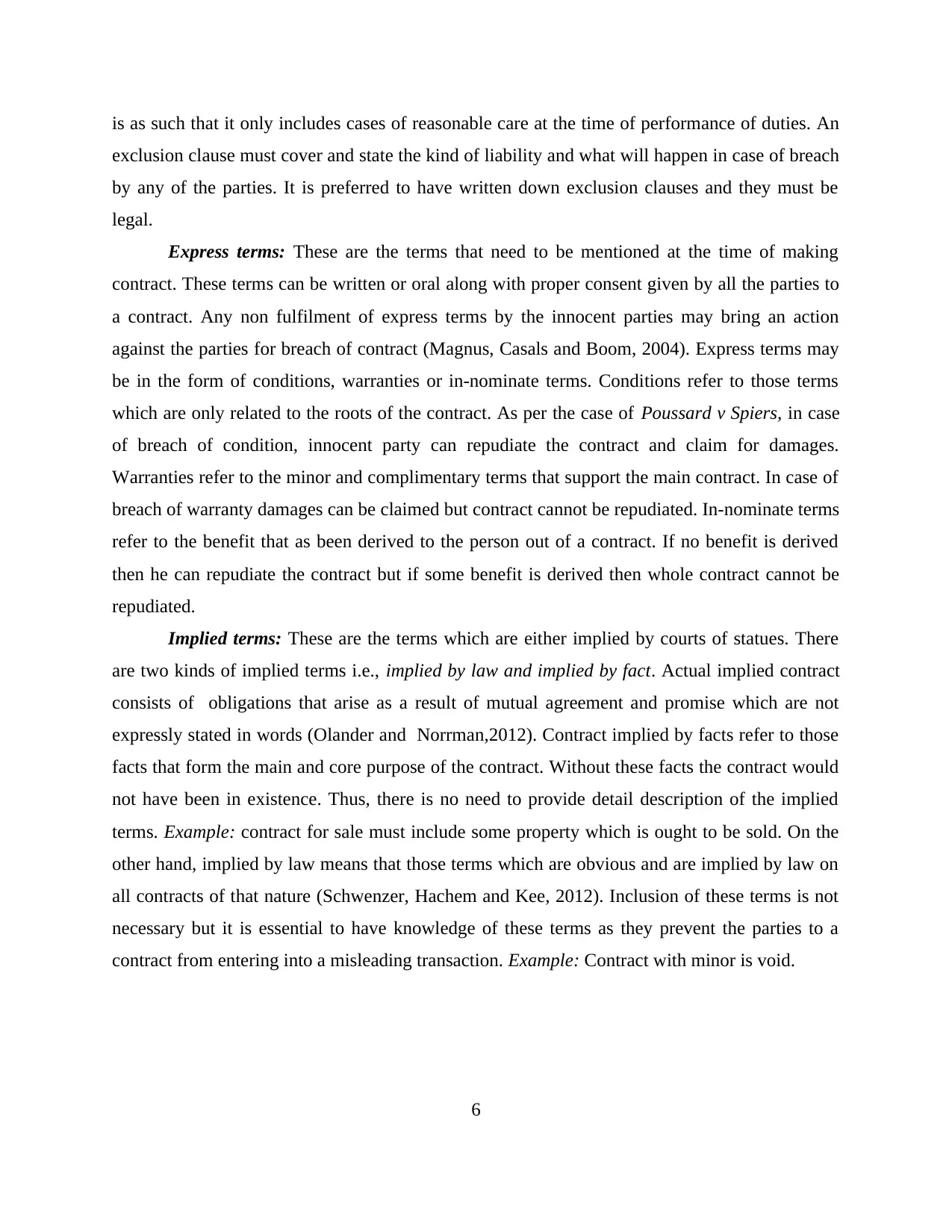
is as such that it only includes cases of reasonable care at the time of performance of duties. An
exclusion clause must cover and state the kind of liability and what will happen in case of breach
by any of the parties. It is preferred to have written down exclusion clauses and they must be
legal.
Express terms: These are the terms that need to be mentioned at the time of making
contract. These terms can be written or oral along with proper consent given by all the parties to
a contract. Any non fulfilment of express terms by the innocent parties may bring an action
against the parties for breach of contract (Magnus, Casals and Boom, 2004). Express terms may
be in the form of conditions, warranties or in-nominate terms. Conditions refer to those terms
which are only related to the roots of the contract. As per the case of Poussard v Spiers, in case
of breach of condition, innocent party can repudiate the contract and claim for damages.
Warranties refer to the minor and complimentary terms that support the main contract. In case of
breach of warranty damages can be claimed but contract cannot be repudiated. In-nominate terms
refer to the benefit that as been derived to the person out of a contract. If no benefit is derived
then he can repudiate the contract but if some benefit is derived then whole contract cannot be
repudiated.
Implied terms: These are the terms which are either implied by courts of statues. There
are two kinds of implied terms i.e., implied by law and implied by fact. Actual implied contract
consists of obligations that arise as a result of mutual agreement and promise which are not
expressly stated in words (Olander and Norrman,2012). Contract implied by facts refer to those
facts that form the main and core purpose of the contract. Without these facts the contract would
not have been in existence. Thus, there is no need to provide detail description of the implied
terms. Example: contract for sale must include some property which is ought to be sold. On the
other hand, implied by law means that those terms which are obvious and are implied by law on
all contracts of that nature (Schwenzer, Hachem and Kee, 2012). Inclusion of these terms is not
necessary but it is essential to have knowledge of these terms as they prevent the parties to a
contract from entering into a misleading transaction. Example: Contract with minor is void.
6
exclusion clause must cover and state the kind of liability and what will happen in case of breach
by any of the parties. It is preferred to have written down exclusion clauses and they must be
legal.
Express terms: These are the terms that need to be mentioned at the time of making
contract. These terms can be written or oral along with proper consent given by all the parties to
a contract. Any non fulfilment of express terms by the innocent parties may bring an action
against the parties for breach of contract (Magnus, Casals and Boom, 2004). Express terms may
be in the form of conditions, warranties or in-nominate terms. Conditions refer to those terms
which are only related to the roots of the contract. As per the case of Poussard v Spiers, in case
of breach of condition, innocent party can repudiate the contract and claim for damages.
Warranties refer to the minor and complimentary terms that support the main contract. In case of
breach of warranty damages can be claimed but contract cannot be repudiated. In-nominate terms
refer to the benefit that as been derived to the person out of a contract. If no benefit is derived
then he can repudiate the contract but if some benefit is derived then whole contract cannot be
repudiated.
Implied terms: These are the terms which are either implied by courts of statues. There
are two kinds of implied terms i.e., implied by law and implied by fact. Actual implied contract
consists of obligations that arise as a result of mutual agreement and promise which are not
expressly stated in words (Olander and Norrman,2012). Contract implied by facts refer to those
facts that form the main and core purpose of the contract. Without these facts the contract would
not have been in existence. Thus, there is no need to provide detail description of the implied
terms. Example: contract for sale must include some property which is ought to be sold. On the
other hand, implied by law means that those terms which are obvious and are implied by law on
all contracts of that nature (Schwenzer, Hachem and Kee, 2012). Inclusion of these terms is not
necessary but it is essential to have knowledge of these terms as they prevent the parties to a
contract from entering into a misleading transaction. Example: Contract with minor is void.
6
⊘ This is a preview!⊘
Do you want full access?
Subscribe today to unlock all pages.

Trusted by 1+ million students worldwide
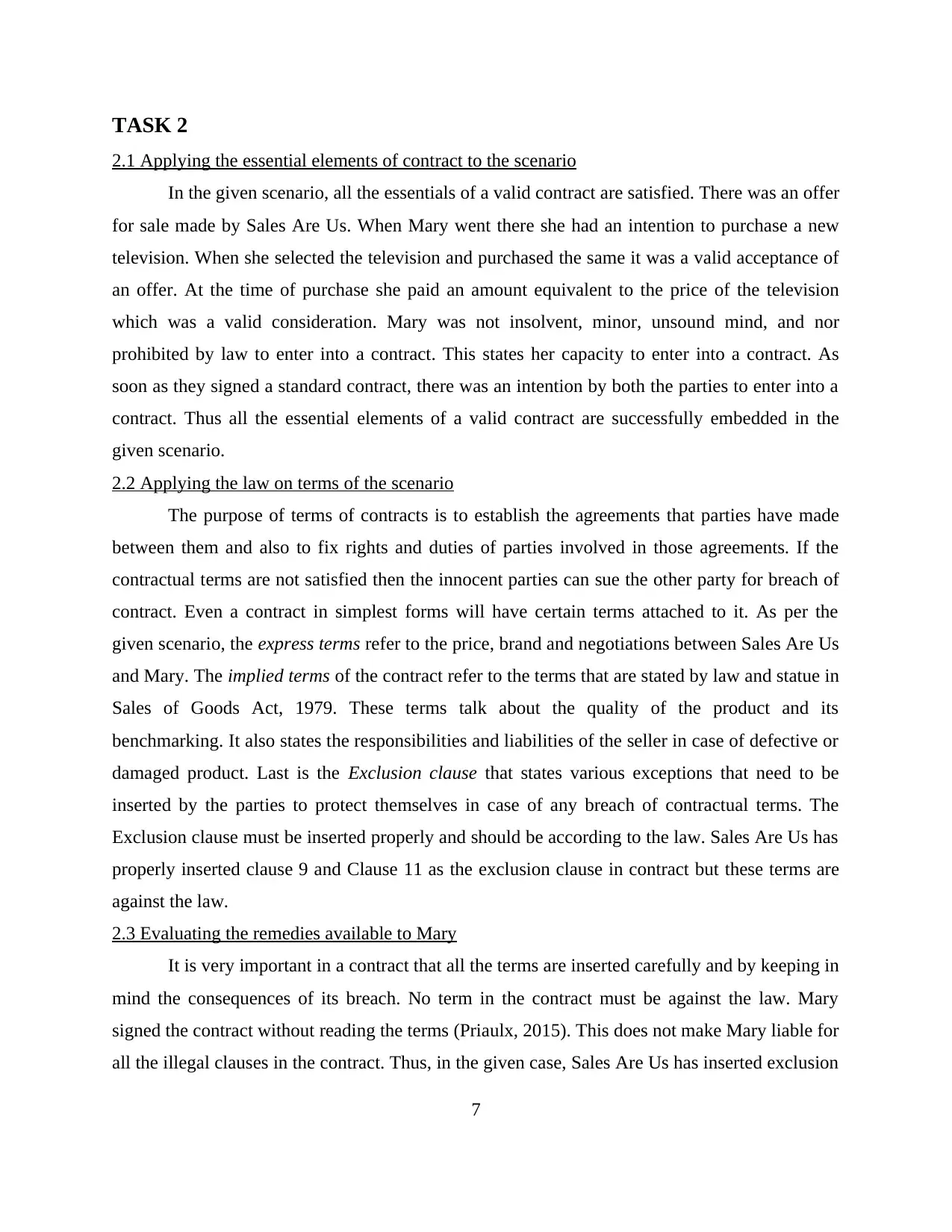
TASK 2
2.1 Applying the essential elements of contract to the scenario
In the given scenario, all the essentials of a valid contract are satisfied. There was an offer
for sale made by Sales Are Us. When Mary went there she had an intention to purchase a new
television. When she selected the television and purchased the same it was a valid acceptance of
an offer. At the time of purchase she paid an amount equivalent to the price of the television
which was a valid consideration. Mary was not insolvent, minor, unsound mind, and nor
prohibited by law to enter into a contract. This states her capacity to enter into a contract. As
soon as they signed a standard contract, there was an intention by both the parties to enter into a
contract. Thus all the essential elements of a valid contract are successfully embedded in the
given scenario.
2.2 Applying the law on terms of the scenario
The purpose of terms of contracts is to establish the agreements that parties have made
between them and also to fix rights and duties of parties involved in those agreements. If the
contractual terms are not satisfied then the innocent parties can sue the other party for breach of
contract. Even a contract in simplest forms will have certain terms attached to it. As per the
given scenario, the express terms refer to the price, brand and negotiations between Sales Are Us
and Mary. The implied terms of the contract refer to the terms that are stated by law and statue in
Sales of Goods Act, 1979. These terms talk about the quality of the product and its
benchmarking. It also states the responsibilities and liabilities of the seller in case of defective or
damaged product. Last is the Exclusion clause that states various exceptions that need to be
inserted by the parties to protect themselves in case of any breach of contractual terms. The
Exclusion clause must be inserted properly and should be according to the law. Sales Are Us has
properly inserted clause 9 and Clause 11 as the exclusion clause in contract but these terms are
against the law.
2.3 Evaluating the remedies available to Mary
It is very important in a contract that all the terms are inserted carefully and by keeping in
mind the consequences of its breach. No term in the contract must be against the law. Mary
signed the contract without reading the terms (Priaulx, 2015). This does not make Mary liable for
all the illegal clauses in the contract. Thus, in the given case, Sales Are Us has inserted exclusion
7
2.1 Applying the essential elements of contract to the scenario
In the given scenario, all the essentials of a valid contract are satisfied. There was an offer
for sale made by Sales Are Us. When Mary went there she had an intention to purchase a new
television. When she selected the television and purchased the same it was a valid acceptance of
an offer. At the time of purchase she paid an amount equivalent to the price of the television
which was a valid consideration. Mary was not insolvent, minor, unsound mind, and nor
prohibited by law to enter into a contract. This states her capacity to enter into a contract. As
soon as they signed a standard contract, there was an intention by both the parties to enter into a
contract. Thus all the essential elements of a valid contract are successfully embedded in the
given scenario.
2.2 Applying the law on terms of the scenario
The purpose of terms of contracts is to establish the agreements that parties have made
between them and also to fix rights and duties of parties involved in those agreements. If the
contractual terms are not satisfied then the innocent parties can sue the other party for breach of
contract. Even a contract in simplest forms will have certain terms attached to it. As per the
given scenario, the express terms refer to the price, brand and negotiations between Sales Are Us
and Mary. The implied terms of the contract refer to the terms that are stated by law and statue in
Sales of Goods Act, 1979. These terms talk about the quality of the product and its
benchmarking. It also states the responsibilities and liabilities of the seller in case of defective or
damaged product. Last is the Exclusion clause that states various exceptions that need to be
inserted by the parties to protect themselves in case of any breach of contractual terms. The
Exclusion clause must be inserted properly and should be according to the law. Sales Are Us has
properly inserted clause 9 and Clause 11 as the exclusion clause in contract but these terms are
against the law.
2.3 Evaluating the remedies available to Mary
It is very important in a contract that all the terms are inserted carefully and by keeping in
mind the consequences of its breach. No term in the contract must be against the law. Mary
signed the contract without reading the terms (Priaulx, 2015). This does not make Mary liable for
all the illegal clauses in the contract. Thus, in the given case, Sales Are Us has inserted exclusion
7
Paraphrase This Document
Need a fresh take? Get an instant paraphrase of this document with our AI Paraphraser
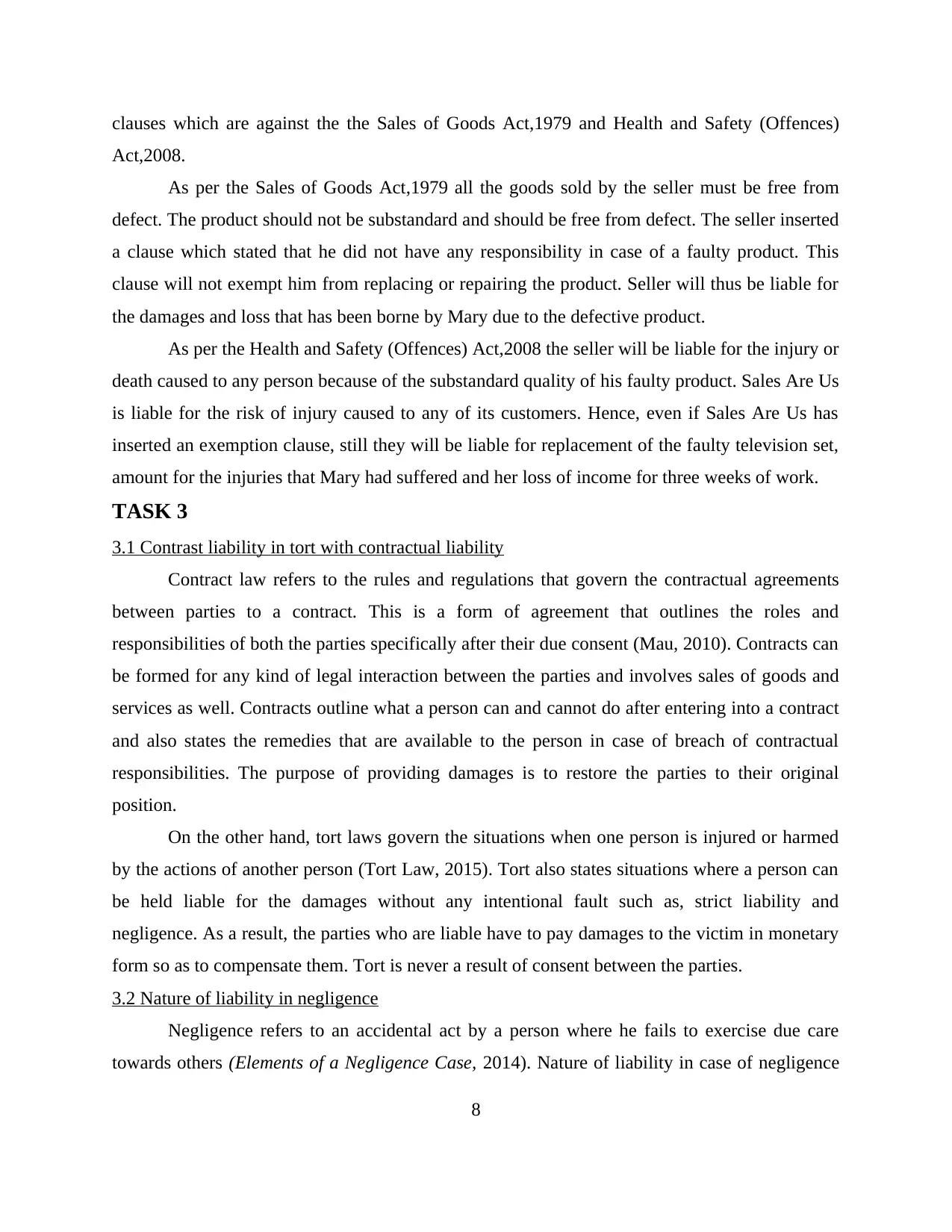
clauses which are against the the Sales of Goods Act,1979 and Health and Safety (Offences)
Act,2008.
As per the Sales of Goods Act,1979 all the goods sold by the seller must be free from
defect. The product should not be substandard and should be free from defect. The seller inserted
a clause which stated that he did not have any responsibility in case of a faulty product. This
clause will not exempt him from replacing or repairing the product. Seller will thus be liable for
the damages and loss that has been borne by Mary due to the defective product.
As per the Health and Safety (Offences) Act,2008 the seller will be liable for the injury or
death caused to any person because of the substandard quality of his faulty product. Sales Are Us
is liable for the risk of injury caused to any of its customers. Hence, even if Sales Are Us has
inserted an exemption clause, still they will be liable for replacement of the faulty television set,
amount for the injuries that Mary had suffered and her loss of income for three weeks of work.
TASK 3
3.1 Contrast liability in tort with contractual liability
Contract law refers to the rules and regulations that govern the contractual agreements
between parties to a contract. This is a form of agreement that outlines the roles and
responsibilities of both the parties specifically after their due consent (Mau, 2010). Contracts can
be formed for any kind of legal interaction between the parties and involves sales of goods and
services as well. Contracts outline what a person can and cannot do after entering into a contract
and also states the remedies that are available to the person in case of breach of contractual
responsibilities. The purpose of providing damages is to restore the parties to their original
position.
On the other hand, tort laws govern the situations when one person is injured or harmed
by the actions of another person (Tort Law, 2015). Tort also states situations where a person can
be held liable for the damages without any intentional fault such as, strict liability and
negligence. As a result, the parties who are liable have to pay damages to the victim in monetary
form so as to compensate them. Tort is never a result of consent between the parties.
3.2 Nature of liability in negligence
Negligence refers to an accidental act by a person where he fails to exercise due care
towards others (Elements of a Negligence Case, 2014). Nature of liability in case of negligence
8
Act,2008.
As per the Sales of Goods Act,1979 all the goods sold by the seller must be free from
defect. The product should not be substandard and should be free from defect. The seller inserted
a clause which stated that he did not have any responsibility in case of a faulty product. This
clause will not exempt him from replacing or repairing the product. Seller will thus be liable for
the damages and loss that has been borne by Mary due to the defective product.
As per the Health and Safety (Offences) Act,2008 the seller will be liable for the injury or
death caused to any person because of the substandard quality of his faulty product. Sales Are Us
is liable for the risk of injury caused to any of its customers. Hence, even if Sales Are Us has
inserted an exemption clause, still they will be liable for replacement of the faulty television set,
amount for the injuries that Mary had suffered and her loss of income for three weeks of work.
TASK 3
3.1 Contrast liability in tort with contractual liability
Contract law refers to the rules and regulations that govern the contractual agreements
between parties to a contract. This is a form of agreement that outlines the roles and
responsibilities of both the parties specifically after their due consent (Mau, 2010). Contracts can
be formed for any kind of legal interaction between the parties and involves sales of goods and
services as well. Contracts outline what a person can and cannot do after entering into a contract
and also states the remedies that are available to the person in case of breach of contractual
responsibilities. The purpose of providing damages is to restore the parties to their original
position.
On the other hand, tort laws govern the situations when one person is injured or harmed
by the actions of another person (Tort Law, 2015). Tort also states situations where a person can
be held liable for the damages without any intentional fault such as, strict liability and
negligence. As a result, the parties who are liable have to pay damages to the victim in monetary
form so as to compensate them. Tort is never a result of consent between the parties.
3.2 Nature of liability in negligence
Negligence refers to an accidental act by a person where he fails to exercise due care
towards others (Elements of a Negligence Case, 2014). Nature of liability in case of negligence
8
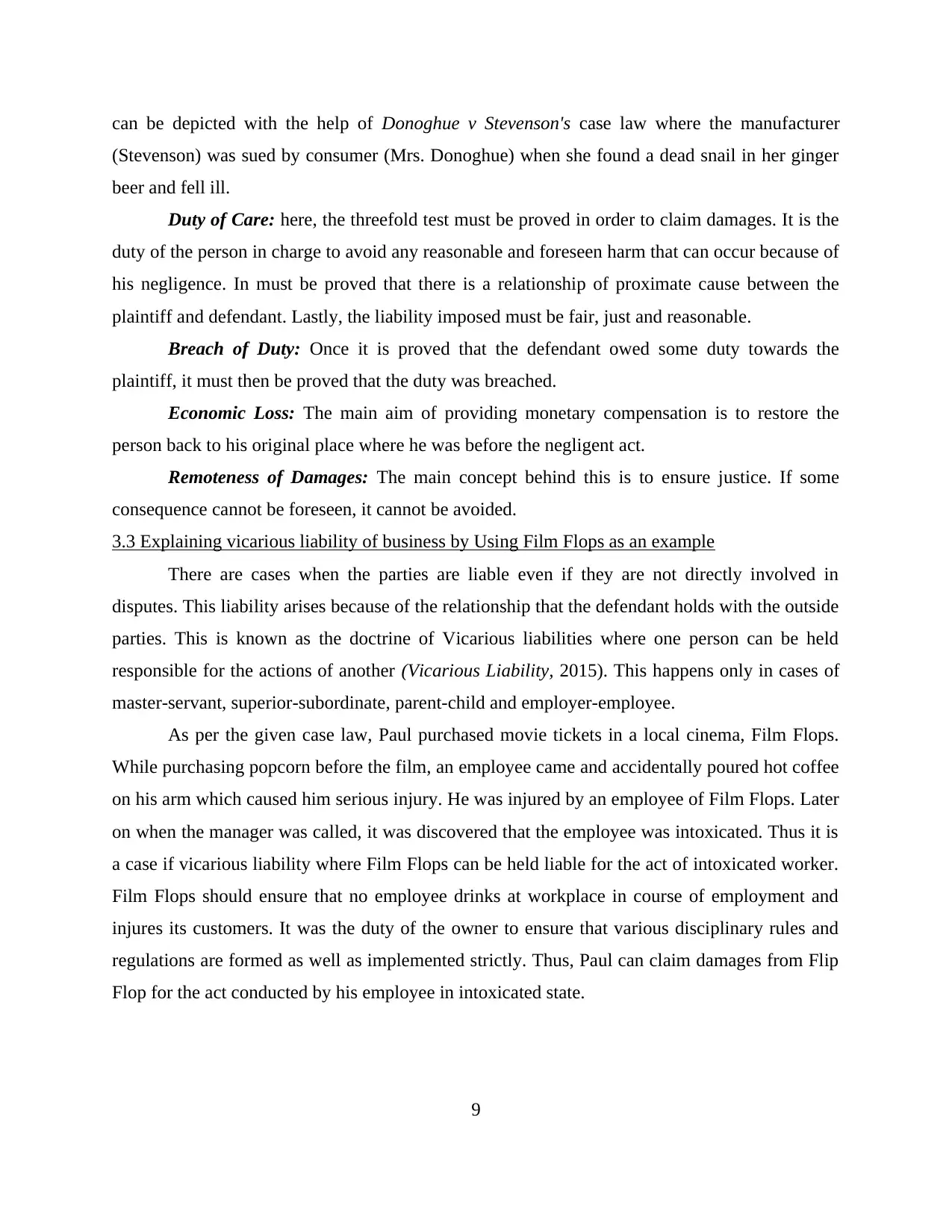
can be depicted with the help of Donoghue v Stevenson's case law where the manufacturer
(Stevenson) was sued by consumer (Mrs. Donoghue) when she found a dead snail in her ginger
beer and fell ill.
Duty of Care: here, the threefold test must be proved in order to claim damages. It is the
duty of the person in charge to avoid any reasonable and foreseen harm that can occur because of
his negligence. In must be proved that there is a relationship of proximate cause between the
plaintiff and defendant. Lastly, the liability imposed must be fair, just and reasonable.
Breach of Duty: Once it is proved that the defendant owed some duty towards the
plaintiff, it must then be proved that the duty was breached.
Economic Loss: The main aim of providing monetary compensation is to restore the
person back to his original place where he was before the negligent act.
Remoteness of Damages: The main concept behind this is to ensure justice. If some
consequence cannot be foreseen, it cannot be avoided.
3.3 Explaining vicarious liability of business by Using Film Flops as an example
There are cases when the parties are liable even if they are not directly involved in
disputes. This liability arises because of the relationship that the defendant holds with the outside
parties. This is known as the doctrine of Vicarious liabilities where one person can be held
responsible for the actions of another (Vicarious Liability, 2015). This happens only in cases of
master-servant, superior-subordinate, parent-child and employer-employee.
As per the given case law, Paul purchased movie tickets in a local cinema, Film Flops.
While purchasing popcorn before the film, an employee came and accidentally poured hot coffee
on his arm which caused him serious injury. He was injured by an employee of Film Flops. Later
on when the manager was called, it was discovered that the employee was intoxicated. Thus it is
a case if vicarious liability where Film Flops can be held liable for the act of intoxicated worker.
Film Flops should ensure that no employee drinks at workplace in course of employment and
injures its customers. It was the duty of the owner to ensure that various disciplinary rules and
regulations are formed as well as implemented strictly. Thus, Paul can claim damages from Flip
Flop for the act conducted by his employee in intoxicated state.
9
(Stevenson) was sued by consumer (Mrs. Donoghue) when she found a dead snail in her ginger
beer and fell ill.
Duty of Care: here, the threefold test must be proved in order to claim damages. It is the
duty of the person in charge to avoid any reasonable and foreseen harm that can occur because of
his negligence. In must be proved that there is a relationship of proximate cause between the
plaintiff and defendant. Lastly, the liability imposed must be fair, just and reasonable.
Breach of Duty: Once it is proved that the defendant owed some duty towards the
plaintiff, it must then be proved that the duty was breached.
Economic Loss: The main aim of providing monetary compensation is to restore the
person back to his original place where he was before the negligent act.
Remoteness of Damages: The main concept behind this is to ensure justice. If some
consequence cannot be foreseen, it cannot be avoided.
3.3 Explaining vicarious liability of business by Using Film Flops as an example
There are cases when the parties are liable even if they are not directly involved in
disputes. This liability arises because of the relationship that the defendant holds with the outside
parties. This is known as the doctrine of Vicarious liabilities where one person can be held
responsible for the actions of another (Vicarious Liability, 2015). This happens only in cases of
master-servant, superior-subordinate, parent-child and employer-employee.
As per the given case law, Paul purchased movie tickets in a local cinema, Film Flops.
While purchasing popcorn before the film, an employee came and accidentally poured hot coffee
on his arm which caused him serious injury. He was injured by an employee of Film Flops. Later
on when the manager was called, it was discovered that the employee was intoxicated. Thus it is
a case if vicarious liability where Film Flops can be held liable for the act of intoxicated worker.
Film Flops should ensure that no employee drinks at workplace in course of employment and
injures its customers. It was the duty of the owner to ensure that various disciplinary rules and
regulations are formed as well as implemented strictly. Thus, Paul can claim damages from Flip
Flop for the act conducted by his employee in intoxicated state.
9
⊘ This is a preview!⊘
Do you want full access?
Subscribe today to unlock all pages.

Trusted by 1+ million students worldwide
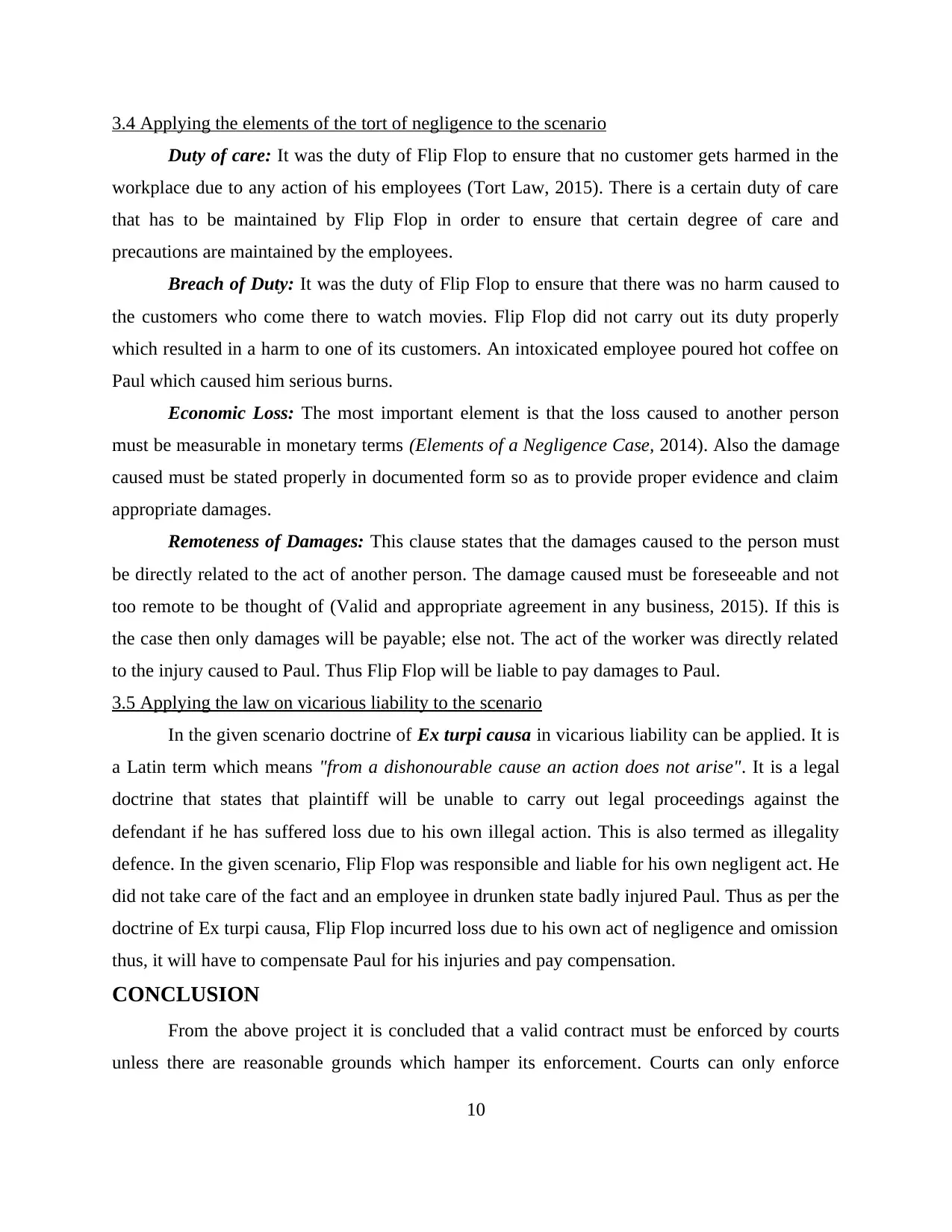
3.4 Applying the elements of the tort of negligence to the scenario
Duty of care: It was the duty of Flip Flop to ensure that no customer gets harmed in the
workplace due to any action of his employees (Tort Law, 2015). There is a certain duty of care
that has to be maintained by Flip Flop in order to ensure that certain degree of care and
precautions are maintained by the employees.
Breach of Duty: It was the duty of Flip Flop to ensure that there was no harm caused to
the customers who come there to watch movies. Flip Flop did not carry out its duty properly
which resulted in a harm to one of its customers. An intoxicated employee poured hot coffee on
Paul which caused him serious burns.
Economic Loss: The most important element is that the loss caused to another person
must be measurable in monetary terms (Elements of a Negligence Case, 2014). Also the damage
caused must be stated properly in documented form so as to provide proper evidence and claim
appropriate damages.
Remoteness of Damages: This clause states that the damages caused to the person must
be directly related to the act of another person. The damage caused must be foreseeable and not
too remote to be thought of (Valid and appropriate agreement in any business, 2015). If this is
the case then only damages will be payable; else not. The act of the worker was directly related
to the injury caused to Paul. Thus Flip Flop will be liable to pay damages to Paul.
3.5 Applying the law on vicarious liability to the scenario
In the given scenario doctrine of Ex turpi causa in vicarious liability can be applied. It is
a Latin term which means "from a dishonourable cause an action does not arise". It is a legal
doctrine that states that plaintiff will be unable to carry out legal proceedings against the
defendant if he has suffered loss due to his own illegal action. This is also termed as illegality
defence. In the given scenario, Flip Flop was responsible and liable for his own negligent act. He
did not take care of the fact and an employee in drunken state badly injured Paul. Thus as per the
doctrine of Ex turpi causa, Flip Flop incurred loss due to his own act of negligence and omission
thus, it will have to compensate Paul for his injuries and pay compensation.
CONCLUSION
From the above project it is concluded that a valid contract must be enforced by courts
unless there are reasonable grounds which hamper its enforcement. Courts can only enforce
10
Duty of care: It was the duty of Flip Flop to ensure that no customer gets harmed in the
workplace due to any action of his employees (Tort Law, 2015). There is a certain duty of care
that has to be maintained by Flip Flop in order to ensure that certain degree of care and
precautions are maintained by the employees.
Breach of Duty: It was the duty of Flip Flop to ensure that there was no harm caused to
the customers who come there to watch movies. Flip Flop did not carry out its duty properly
which resulted in a harm to one of its customers. An intoxicated employee poured hot coffee on
Paul which caused him serious burns.
Economic Loss: The most important element is that the loss caused to another person
must be measurable in monetary terms (Elements of a Negligence Case, 2014). Also the damage
caused must be stated properly in documented form so as to provide proper evidence and claim
appropriate damages.
Remoteness of Damages: This clause states that the damages caused to the person must
be directly related to the act of another person. The damage caused must be foreseeable and not
too remote to be thought of (Valid and appropriate agreement in any business, 2015). If this is
the case then only damages will be payable; else not. The act of the worker was directly related
to the injury caused to Paul. Thus Flip Flop will be liable to pay damages to Paul.
3.5 Applying the law on vicarious liability to the scenario
In the given scenario doctrine of Ex turpi causa in vicarious liability can be applied. It is
a Latin term which means "from a dishonourable cause an action does not arise". It is a legal
doctrine that states that plaintiff will be unable to carry out legal proceedings against the
defendant if he has suffered loss due to his own illegal action. This is also termed as illegality
defence. In the given scenario, Flip Flop was responsible and liable for his own negligent act. He
did not take care of the fact and an employee in drunken state badly injured Paul. Thus as per the
doctrine of Ex turpi causa, Flip Flop incurred loss due to his own act of negligence and omission
thus, it will have to compensate Paul for his injuries and pay compensation.
CONCLUSION
From the above project it is concluded that a valid contract must be enforced by courts
unless there are reasonable grounds which hamper its enforcement. Courts can only enforce
10
Paraphrase This Document
Need a fresh take? Get an instant paraphrase of this document with our AI Paraphraser
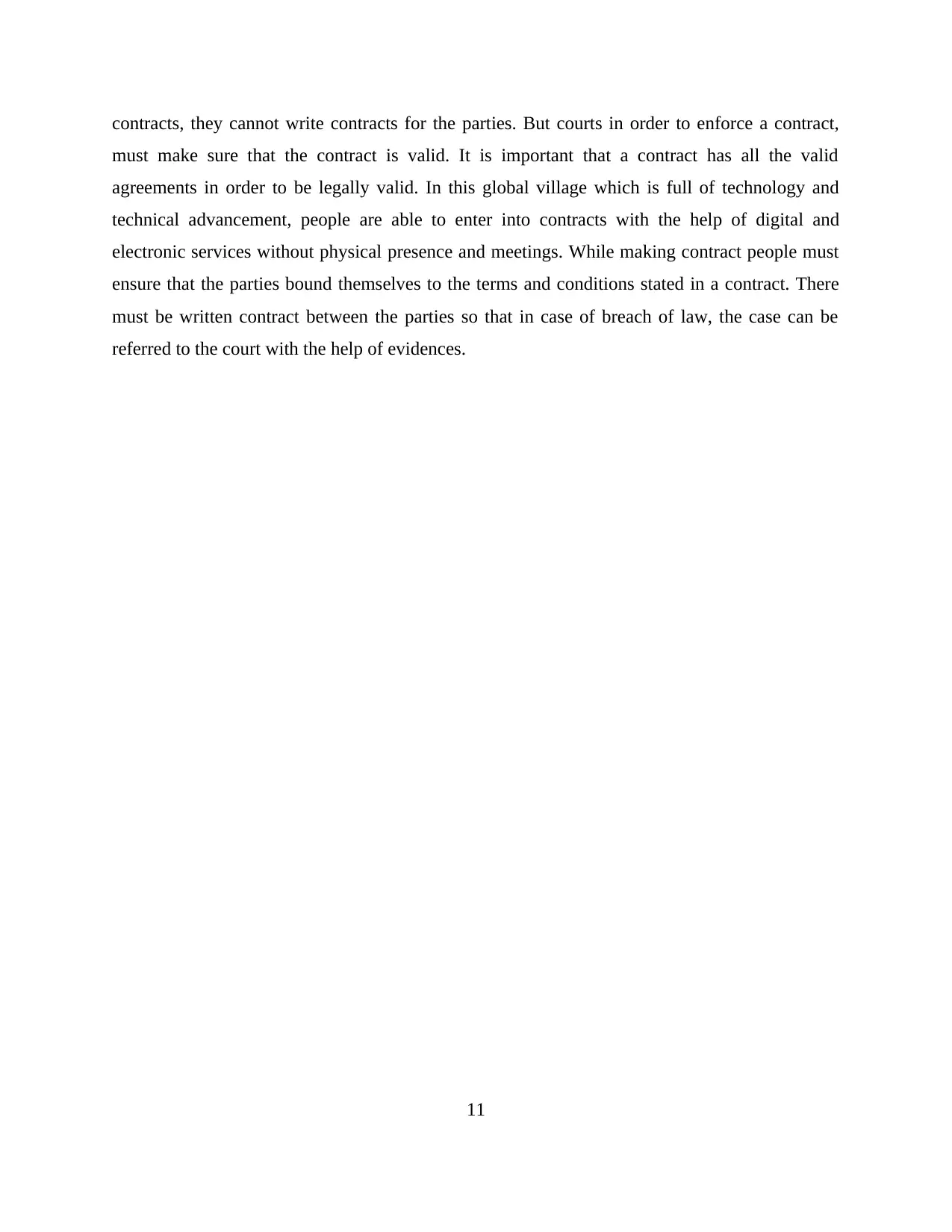
contracts, they cannot write contracts for the parties. But courts in order to enforce a contract,
must make sure that the contract is valid. It is important that a contract has all the valid
agreements in order to be legally valid. In this global village which is full of technology and
technical advancement, people are able to enter into contracts with the help of digital and
electronic services without physical presence and meetings. While making contract people must
ensure that the parties bound themselves to the terms and conditions stated in a contract. There
must be written contract between the parties so that in case of breach of law, the case can be
referred to the court with the help of evidences.
11
must make sure that the contract is valid. It is important that a contract has all the valid
agreements in order to be legally valid. In this global village which is full of technology and
technical advancement, people are able to enter into contracts with the help of digital and
electronic services without physical presence and meetings. While making contract people must
ensure that the parties bound themselves to the terms and conditions stated in a contract. There
must be written contract between the parties so that in case of breach of law, the case can be
referred to the court with the help of evidences.
11
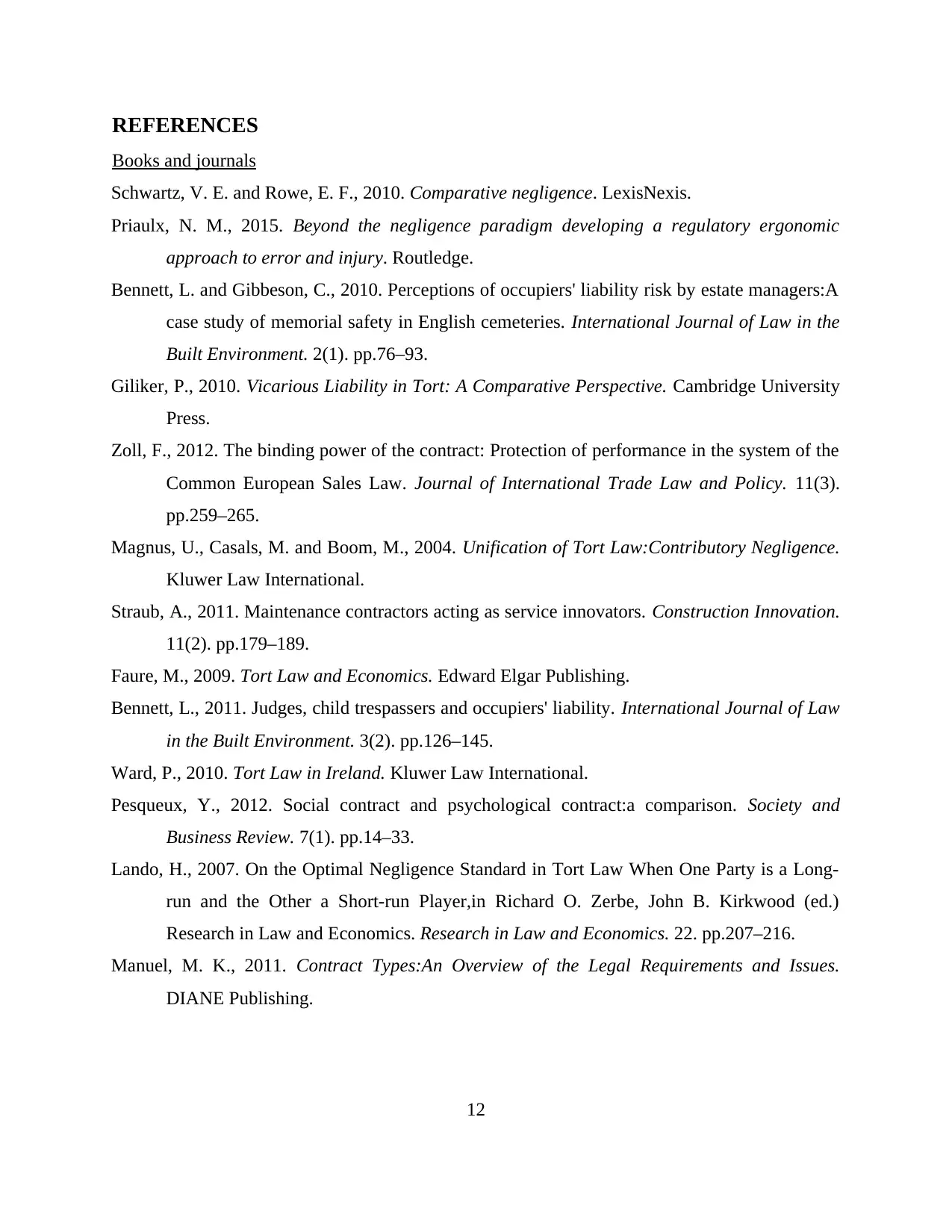
REFERENCES
Books and journals
Schwartz, V. E. and Rowe, E. F., 2010. Comparative negligence. LexisNexis.
Priaulx, N. M., 2015. Beyond the negligence paradigm developing a regulatory ergonomic
approach to error and injury. Routledge.
Bennett, L. and Gibbeson, C., 2010. Perceptions of occupiers' liability risk by estate managers:A
case study of memorial safety in English cemeteries. International Journal of Law in the
Built Environment. 2(1). pp.76–93.
Giliker, P., 2010. Vicarious Liability in Tort: A Comparative Perspective. Cambridge University
Press.
Zoll, F., 2012. The binding power of the contract: Protection of performance in the system of the
Common European Sales Law. Journal of International Trade Law and Policy. 11(3).
pp.259–265.
Magnus, U., Casals, M. and Boom, M., 2004. Unification of Tort Law:Contributory Negligence.
Kluwer Law International.
Straub, A., 2011. Maintenance contractors acting as service innovators. Construction Innovation.
11(2). pp.179–189.
Faure, M., 2009. Tort Law and Economics. Edward Elgar Publishing.
Bennett, L., 2011. Judges, child trespassers and occupiers' liability. International Journal of Law
in the Built Environment. 3(2). pp.126–145.
Ward, P., 2010. Tort Law in Ireland. Kluwer Law International.
Pesqueux, Y., 2012. Social contract and psychological contract:a comparison. Society and
Business Review. 7(1). pp.14–33.
Lando, H., 2007. On the Optimal Negligence Standard in Tort Law When One Party is a Long-
run and the Other a Short-run Player,in Richard O. Zerbe, John B. Kirkwood (ed.)
Research in Law and Economics. Research in Law and Economics. 22. pp.207–216.
Manuel, M. K., 2011. Contract Types:An Overview of the Legal Requirements and Issues.
DIANE Publishing.
12
Books and journals
Schwartz, V. E. and Rowe, E. F., 2010. Comparative negligence. LexisNexis.
Priaulx, N. M., 2015. Beyond the negligence paradigm developing a regulatory ergonomic
approach to error and injury. Routledge.
Bennett, L. and Gibbeson, C., 2010. Perceptions of occupiers' liability risk by estate managers:A
case study of memorial safety in English cemeteries. International Journal of Law in the
Built Environment. 2(1). pp.76–93.
Giliker, P., 2010. Vicarious Liability in Tort: A Comparative Perspective. Cambridge University
Press.
Zoll, F., 2012. The binding power of the contract: Protection of performance in the system of the
Common European Sales Law. Journal of International Trade Law and Policy. 11(3).
pp.259–265.
Magnus, U., Casals, M. and Boom, M., 2004. Unification of Tort Law:Contributory Negligence.
Kluwer Law International.
Straub, A., 2011. Maintenance contractors acting as service innovators. Construction Innovation.
11(2). pp.179–189.
Faure, M., 2009. Tort Law and Economics. Edward Elgar Publishing.
Bennett, L., 2011. Judges, child trespassers and occupiers' liability. International Journal of Law
in the Built Environment. 3(2). pp.126–145.
Ward, P., 2010. Tort Law in Ireland. Kluwer Law International.
Pesqueux, Y., 2012. Social contract and psychological contract:a comparison. Society and
Business Review. 7(1). pp.14–33.
Lando, H., 2007. On the Optimal Negligence Standard in Tort Law When One Party is a Long-
run and the Other a Short-run Player,in Richard O. Zerbe, John B. Kirkwood (ed.)
Research in Law and Economics. Research in Law and Economics. 22. pp.207–216.
Manuel, M. K., 2011. Contract Types:An Overview of the Legal Requirements and Issues.
DIANE Publishing.
12
⊘ This is a preview!⊘
Do you want full access?
Subscribe today to unlock all pages.

Trusted by 1+ million students worldwide
1 out of 13
Related Documents
Your All-in-One AI-Powered Toolkit for Academic Success.
+13062052269
info@desklib.com
Available 24*7 on WhatsApp / Email
![[object Object]](/_next/static/media/star-bottom.7253800d.svg)
Unlock your academic potential
Copyright © 2020–2025 A2Z Services. All Rights Reserved. Developed and managed by ZUCOL.





